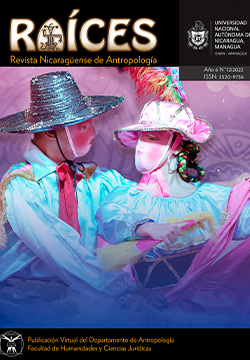Living in transition in Estado de México:
Nahuas, purepechas and totonacas resisting overmodernity
DOI:
https://doi.org/10.5377/raices.v6i12.15572Keywords:
Overmodernity, identity, ethnic, resistance, migrationAbstract
In the town of San Francisco Tepojaco, Cuautitlán Izcalli, State of Mexico, there are migrants belonging to the Nahua, Purépecha and Totonaca ethnic groups. Its identity construction occurs in a dynamic and multivalent way, showing that reviewing its systems of belonging is one of the great challenges of supermodernity. This scientific article is the result of an ethnographic analysis carried out on indigenous settlements within the aforementioned town. The processes and practices that they carry out in the new spaces of residence, far from their place of origin, constitute multifaceted and peculiar scenarios in the conformation of their ethnic feeling, which represents a cultural resistance. The results of the research explain that ethnic identities in overmodernity have the characteristic of being ephemeral, changing and indefinite, since they are governed by the anthroposociohistorical context in which they occur. Thus, their systems of belonging are constantly redefined according to the time and place where they are. Derived from this, ethnic migrants who seek to establish themselves in rural-urban transition spaces are aware that they will play ambivalently with the elements that define them depending on the circumstances in which they find themselves. With the field work, the existing paradigms began to be questioned and a look was approached from a sociocultural and more neutral perspective, focusing on the particularities and relativism from the native’s perspective, but without losing the interpretive question that science requires. anthropological. The qualitative interview was also used as a technique to confirm the information provided by the study subjects.
Downloads
References
Augé, Marc. “Anonimato y sobremodernidad”. Espai en Blanc, 2009. Acceso: 29/03/2022.
Bauman, Zygmunt. Modernidad liquida. Fondo de Cultura Económica: 2007.
Bazán, Claudia. “Saliendo de los márgenes: las transformaciones de la subjetividad en el marco de una acción política alternativa”. Universidad de Buenos Aires, 2012. Acceso: 29/03/2022.
De la Peña, Guillermo. “El enfoque situacional y el estudio de redes y asociaciones urbanas en contextos pluriétnicos”. Revista Nueva Antropología, 2015. Acceso: 29/03/2022.
Gómez, Pedro. “La identidad étnica, la manía nacionalista y el multiculturalismo como rebrotes racistas y amenazas contra la humanidad”. Gazeta de Antropología, 2012. Acceso: 29/03/2022.
Lipovetsky, Gilles. La era del vacío. Anagrama, 1983.
López, Juan. “Una aproximación a la crisis de identidades y una propuesta de investigación empírica”. Universidad de Granada, 2012. Acceso: 29/03/2022.
Downloads
Published
How to Cite
Issue
Section
License
Copyright (c) 2023 © Universidad Nacional Autónoma de Nicaragua, Managua, UNAN-Managua

This work is licensed under a Creative Commons Attribution-NonCommercial-ShareAlike 4.0 International License.




